|
|
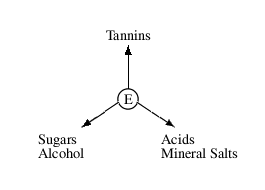 |
|
Balance in Red Wines |
|
The best way to understand red wines, just like any other style of wine, is to
personally evaluate them by means of one's own senses. The practical
application that we are going to suggest for red wines allow the evaluation of
the many organoleptic characteristics and, in particular, how the presence of
the many element can influence balance. In order to try the practical
application we suggest, it is required to have three wines: a plain Cabernet
Sauvignon produced in Friuli Venezia Giulia (Italy), a Merlot having two or
three years of aging in bottle as well as aged in barrique, possibly produced
in Tuscany (Italy) or California (USA), and a Pinot Noir aged for two or three
years and produced in Bourgogne (France) or in Alto Adige (Italy).
The appearance of the three wines shows rather different intensities and
colors. Pinot Noir will be one having the lighter color of them all and will
show a higher transparency, whereas Cabernet Sauvignon and Merlot will both
have colors and nuances practically similar. The first information that can be
determined by these observations is that Pinot Noir has a lesser coloring
capacity, that is contains a little quantity of pigments, as opposed to the
other two grapes, however this does not mean it produces low quality wines,
indeed, Pinot Noir is considered among the great grapes capable of producing
high quality wines. This initial evaluation should help in suppressing the
prejudice that wines having light colors are usually not very good, provided
they are produced with quality production criteria. Even at the nose the three
wines will offer different aromas. In Pinot Noir will be perceived aromas of
cherry, raspberry, red currant and strawberry, as well as aromas of vanilla as
a sign of the probable aging in cask. Merlot's aromas will probably be rather
different. In this wine will be perceived, first of all, aromas of vanilla and
oak because of the aging in cask, however it will be possible to perceive clear
aromas of black cherry, blueberry, plum, probably aromas of blackberry, as well
as aromas of jams and violet. In Cabernet Sauvignon will emerge an aroma that
could be pretty surprising and that would not be expected to be found in a
wine: the aroma of green bell pepper. This “curious” aroma will not probably
be the dominant one, however it will be clearly recognizable among other good
aromas of black currant, blueberry, black cherry and, more likely to be, even
eucalyptus. Lastly, it could be perceived, also in this wine, an aroma of
vanilla, sign of the aging in cask.
Even in the mouth the wines will taste differently. Pinot Noir will seem to be
more crisp, that is more acid, if compared to the other two wines, and its
astringency, produced by tannins, will be pretty low. Merlot will certainly
have a lower acidity, however a higher astringency will be perceived, even
though smooth and pleasing, produced by tannins. Merlot will seem to have a
greater structure and more body as opposed to Pinot Noir. Lastly, Cabernet
Sauvignon will have an even greater astringency if compared to the other two
wines, a sensation of astringency more aggressive and less smooth, and a good
body. It should be considered that quantity of alcohol will probably be the
same in all the three wines, probably from 12 to 13 percent of alcohol by
volume, however the wines, although having different levels of astringency,
will be balanced. In Pinot Noir, having a low astringency, balance is obtained
thanks to the higher quantity of acid whereas in the other two wines acidity is
lower while the astringency is higher.
|
Score legend
 Fair Fair   Pretty Good Pretty Good    Good Good
    Very Good Very Good      Excellent Excellent
 Wine that excels in its category Wine that excels in its category
Prices are to be considered as indicative. Prices may vary according to the country
or the shop where wines are bought
|

|
Barbera del Monferrato Rossad'Ocra 2000 |
| Cascina Maddalena (Italy) |
| Grapes: Barbera |
| Price: € 13,00 |
Score:    |
| The wine shows an intense ruby red color and nuances of ruby red, moderate
transparency. The nose reveals intense aromas of fruit, in particular
black cherry, blueberry, blackberry, plum, violet and hints of vanilla. In
mouth is correspondent to the nose, has a crisp attack balanced by tannins
and alcohol, good body and intense flavors. The finish is persistent with
flavors of black cherry and blueberry. Rossad'Ocra is aged in barrique for
about 12 months. |
| Food Match: Roasted meat, Braised meat with mushrooms, Hard cheese |
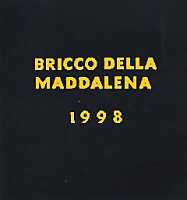
|
Monferrato Rosso Bricco della Maddalena 1998 |
| Cascina Maddalena (Italy) |
| Grapes: Barbera |
| Price: € 25,00 |
Score:     |
| The wine shows a brilliant ruby red color and nuances of ruby red,
moderate transparency. The nose reveals clean and intense aromas, mainly
of fruit, such as black cherry, blueberry and plum followed by aromas of
violet cinchona, pine tree, licorice and vanilla. In mouth has good
correspondence to the nose, a crisp and tannic attack however balanced by
alcohol, present in good quantities. Good body and intense flavors. The
finish is persistent with good flavors of black cherry and plum. This wine
is aged in barrique for 12-15 months. |
| Food Match: Game, Braised and stewed meat with mushrooms, Hard cheese |

|
Grechetto dei Colli Martani Terre di San Nicola 2001 |
| Di Filippo (Italy) |
| Grapes: Grechetto |
| Price: € 4,60 |
Score:     |
| The wine shows a light straw yellow and nuances of straw yellow, very
transparent. The nose reveals intense, clean and pleasing aromas of
pineapple, banana, hawthorn, jasmine, lemon, apple, hazelnut, pear and
peach. In mouth has good correspondence to the nose, a pleasing crisp
attack however well balanced by alcohol. Intense and very agreeable. The
finish is persistent with pleasing flavors of pear, lemon and apple. This
Grechetto is aged in steel tanks. |
| Food Match: Boiled fish, Crustaceans, Pasta and risotto with vegetables and fish, Sauteed meat, Appetizers |

|
Colli Martani Sangiovese Riserva Properzio 1999 |
| Di Filippo (Italy) |
| Grapes: Sangiovese |
| Price: € 5,80 |
Score:     |
| The wine shows an intense ruby red color and nuances of ruby red, moderate
transparency. The nose reveals refined, clean, intense and pleasing aromas
of black cherry, blueberry, plum, violet, carob, licorice and vanilla. In
mouth has a tannic attack however balanced by alcohol, good correspondence
to the nose, intense flavors and good body. The finish is persistent with
good flavors of plum, black cherry and blueberry. A well made wine which
will give its best within 2 years, however it is already drinkable.
Properzio is aged in barrique. |
| Food Match: Game, Broiled meat and barbecue, Roasted meat, Hard cheese |
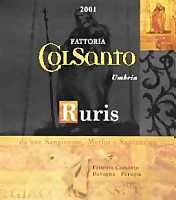
|
Ruris 2001 |
| Fattoria Colsanto (Italy) |
| Grapes: Sangiovese, Merlot, Sagrantino |
| Price: € 8,00 |
Score:     |
| The wine shows a brilliant ruby red color and nuances of garnet red,
moderate transparency. The nose reveals intense, clean and elegant aromas,
mainly of fruit, such as black cherry, blueberry, blackberry, plum and black
currant followed by good aromas of vanilla, caramel and cocoa as well as
hints of green bell pepper. In mouth has good correspondence to the nose, a
slightly tannic attack however well balanced by alcohol, good body and
intense flavors. The finish is persistent with good flavors of black
cherry, plum and blueberry. Ruris is aged for 10 months in barrique. |
| Food Match: Roasted meat, Hard cheese, Stuffed pasta |
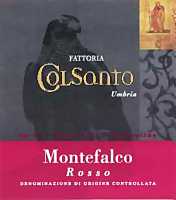
|
Montefalco Rosso 2001 |
| Fattoria Colsanto (Italy) |
| Grapes: Sangiovese, Sagrantino |
| Price: € 9,00 |
Score:     |
| The wine shows a brilliant ruby red color and nuances of ruby red, moderate
transparency. The nose denotes intense, pleasing and clean aromas, mainly
of fruit, such as black cherry, raspberry, blueberry, blackberry and violet
followed by pleasing aromas of vanilla, licorice as well as hints of
coffee. In mouth reveals good correspondence to the nose, a slightly tannic
attack however well balanced by alcohol, good body and intense flavors. The
finish is persistent with flavors of black cherry, blackberry and plum.
This wine is aged for 15 months in barrique followed by 3 months of aging
in bottle. |
| Food Match: Roasted meat, Stewed meat, Hard cheese, Stuffed pasta |
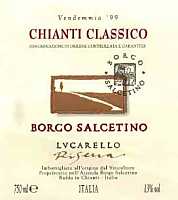
|
Chianti Classico Lucarello Riserva 1999 |
| Borgo Salcetino (Italy) |
| Grapes: Sangiovese, Canaiolo Nero |
| Price: € 13,00 |
Score:     |
| The wine shows an intense ruby red color and nuances of ruby red, moderate
transparency. The nose reveals pleasing, intense and elegant aromas, mainly
of fruit, such as black cherry, raspberry, blueberry, blackberry and plum
followed by intense and good aromas of violet and vanilla as well as hints
of chocolate. In mouth is round and pleasing, very balanced, with smooth
tannins and good body, intense flavors and good correspondence to the nose.
The finish is persistent with pleasing and clean flavors of black cherry,
blueberry and plum. A well made wine. This Chianti reserve is aged in
barrique followed by a long period of aging in bottle. |
| Food Match: Braised meat with mushrooms, Roasted meat, Broiled meat and barbecue, Hard cheese |
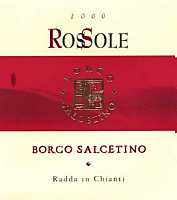
|
RosSole 2000 |
| Borgo Salcetino (Italy) |
| Grapes: Sangiovese (70%), Merlot (30%) |
| Price: € 10,40 |
Score:     |
| The wine has an intense ruby red color and nuances of ruby red, little
transparency. The nose reveals good personality with intense, clean,
elegant and refined aromas of black cherry, blackberry, plum and black
currant followed by good aromas of vanilla, licorice and cocoa as well as
hints of menthol. In mouth is elegant and round, with pleasing tannins and
good correspondence to the nose, good balance, intense flavors and good
body. The finish is persistent with good flavors of black currant, black
cherry and plum. A well made wine. RosSole is aged in barrique for 14
months followed by a long period of aging in bottle. |
| Food Match: Braised meat, Roasted meat, Broiled meat and barbecue, Hard cheese, Game |
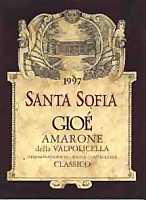
|
Amarone della Valpolicella Classico Gioé 1997 |
| Santa Sofia (Italy) |
| Grapes: Corvina (65%), Rondinella (30%), Molinara (5%) |
| Price: € 35,00 |
Score:      |
| The wine shows an intense ruby red color and nuances of garnet red, little
transparency. The nose reveals personality with elegant, intense, clean
and refined aromas mainly of jams. There can be perceived good aromas of
black cherry jam, blackberry jam and plum jam followed by pleasing and
clean aromas of black cherry macerated in alcohol, cocoa, caramel,
leather, licorice, enamel, violet and vanilla. In mouth has a tannic
attack which is well balanced by alcohol, excellent correspondence to the
nose, intense flavors and full body. The finish is persistent with
pleasing and clean flavors of blackberry jam, black cherry jam and plum
jam. A very well made wine. Amarone Gioé is produced in limited quantities
and only in particularly favorable vintages and ages for 48 months in cask
and 8-12 months in bottle. |
| Food Match: Roasted meat, Hard cheese, Game, Braised meat, Stewed meat |
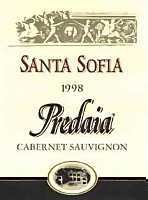
|
Predaia 1998 |
| Santa Sofia (Italy) |
| Grapes: Cabernet Sauvignon (85%), Corvina and Rondinella (15%) |
| Price: € 12,50 |
Score:     |
| The wine has a brilliant ruby red color and nuances of garnet red, moderate
transparency. The note denotes good personality with elegant, intense,
clean and refined aromas of black cherry, blueberry, bell pepper, plum,
black currant and violet followed by good aromas of vanilla, toasted,
caramel and chocolate. In mouth is round, agreeable and balanced, with good
correspondence to the nose, smooth tannins, intense flavors and good body.
The finish is persistent with clean and pleasing flavors of plum, blueberry
and black cherry. A well made wine. Predaia is aged for 12 months in
barrique and for 24 months in cask followed by 8-12 months of aging in
bottle. |
| Food Match: Roasted meat, Stewed meat, Braised meat, Game, Hard cheese |
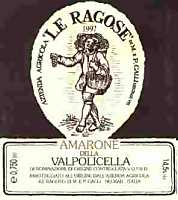
|
Amarone della Valpolicella Classico 1997 |
| Le Ragose (Italy) |
| Grapes: Corvina (50%), Rondinella (20%), Molinara (20%), other grapes (10%) |
| Price: € 23,00 |
Score:     |
| The wine shows an intense ruby red color and nuances of garnet red, little
transparency. The nose denotes intense, clean and elegant aromas such as
black cherry jam, blackberry jam, plum and dried violet followed by
caramel, white pepper, cocoa, walnut and vanilla. In mouth reveals good
correspondence to the nose, a tannic attack well balanced by alcohol,
intense flavors and full body. The finish is persistent with pleasing
flavors of plum, blackberry jam and black cherry jam. This wine is aged
for 12 months in steel tanks followed by 4-5 years of aging in cask. |
| Food Match: Roasted meat, Hard cheese, Game, Braised meat, Stewed meat |
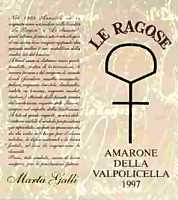
|
Amarone della Valpolicella Classico Marta Galli 1997 |
| Le Ragose (Italy) |
| Grapes: Corvina (50%), Rondinella (20%), Cabernet (5%), other grapes (25%) |
| Price: € 28,50 |
Score:      |
| The wine shows an intense ruby red color and nuances of garnet red, little
transparency. The nose reveals personality with pleasing, clean, intense
and elegant aromas, in particular of jams, such as black cherry jam,
cherry jam, strawberry jam and blackberry jam followed by intense and
clean aromas of black cherry macerated in alcohol, caramel, chocolate,
plum, dried violet and vanilla. In mouth denotes good correspondence to
the nose, a tannin attack well balanced by alcohol, intense flavors and
full body. The finish is persistent with clean flavors of blackberry jam,
cherry jam and plum. A very well made wine. This Amarone is aged for 3
months in steel tanks and for 2 years in cask followed by an aging in
bottle for at least one year. |
| Food Match: Roasted meat, Hard cheese, Game, Braised meat, Stewed meat |
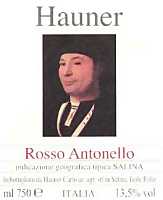
|
Rosso Antonello 1999 |
| Carlo Hauner (Italy) |
| Grapes: Calabrese, Sangiovese, Corinto Nero |
| Price: € 13,20 |
Score:     |
| The wine shows a brilliant ruby red color and nuances of garnet red,
moderate transparency. The nose reveals clean, intense and elegant aromas,
mainly of fruit, such as black cherry, blueberry, blackberry, plum and
carob followed by good aromas of dried rose, violet, cocoa and vanilla. In
mouth had good correspondence to the nose, good balance, intense flavors
and good body. The finish is persistent with pleasing and clean flavors of
black cherry and plum. Rosso Antonello is aged in barrique followed by 9
months of aging in bottle. |
| Food Match: Roasted meat, Broiled meat and barbecue, Hard cheese, Braised meat |
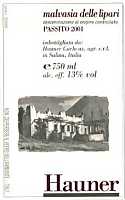
|
Malvasia delle Lipari Passito 2001 |
| Carlo Hauner (Italy) |
| Grapes: Malvasia delle Lipari (95%), Corinto Nero (5%) |
| Price: € 18,00 (500ml - 16.9 fl.oz.Confectionery, Dried fruit tarts especially of almonds, Hard and piquant cheese |
Score:      |
| Simply a great wine. It shows a beautiful and brilliant amber yellow color
and nuances of golden yellow, very transparent. The nose reveals great
personality with intense, elegant, refined, rich and pleasing aromas of
apricot jam, peach jam, candied fruit, date, dried fig, dried flowers,
almond, orange marmalade, honey, hazelnut, citrus fruit peel followed by a
pleasing hint of rosemary. In mouth is rich and charming, adequate
sweetness, smooth and round with intense flavors, very balanced. Excellent
correspondence to the nose. The finish is very persistent with pleasing and
long flavors of apricot, peach, honey, citrus fruit peel and candied fruit.
A truly well made wine, extraordinary also when tasted alone. This Malvasia
delle Lipari is produced with late harvested grapes which are subsequently
dried on mats. The wine ages for 18 months and for 6 months in bottle. |
| Food Match: Confectionery, Dried fruit tarts especially of almonds, Hard and piquant cheese |
| Wine Tasting |
Issue 9, June 2003 
|
|
|
|
Download your free DiWineTaste Card : Test your Blood Alcohol Content : Follow DiWineTaste  

| Copyright © 2002-2024 Antonello Biancalana, DiWineTaste - All rights reserved |
All rights reserved under international copyright conventions. No part of this publication and of this WEB site may be
reproduced or utilized in any form or by any means, electronic or mechanical, without permission in writing from DiWineTaste.
|
|



